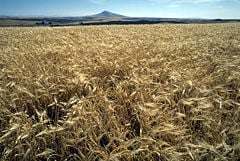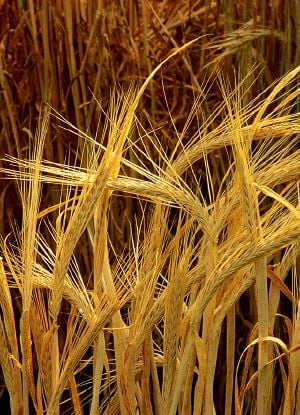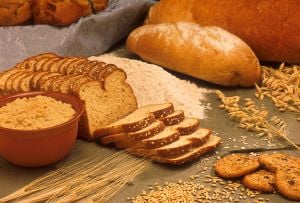Difference between revisions of "Barley" - New World Encyclopedia
Katya Swarts (talk | contribs) (Added article and credit tags) |
Katya Swarts (talk | contribs) |
||
| Line 1: | Line 1: | ||
| − | + | ||
| − | {{ | + | {{Taxobox_begin | color = lightgreen| name = Barley}} |
| − | | color = lightgreen | + | {{Taxobox_image | image = [[Image:Barley.jpg|240px]] | caption = Barley field }} |
| − | | name = Barley | + | {{Taxobox_begin_placement | color = lightgreen}} |
| − | | image = Barley.jpg | + | {{Taxobox_regnum_entry | taxon = [[Plant]]ae}} |
| − | | | + | {{Taxobox_divisio_entry | taxon = [[Magnoliophyta]]}} |
| − | | | + | {{Taxobox_classis_entry | taxon = [[Liliopsida]]}} |
| − | | | + | {{Taxobox_ordo_entry | taxon = [[Poales]]}} |
| − | | | + | {{Taxobox_familia_entry | taxon = [[Poaceae]]}} |
| − | | | + | {{Taxobox_genus_entry | taxon = ''[[Hordeum]]''}} |
| − | | | + | {{Taxobox_species_entry | taxon = '''''H. vulgare'''''}} |
| − | | | + | {{Taxobox_end_placement}} |
| − | | | + | {{Taxobox_section_binomial_botany | color = lightgreen| binomial_name = Hordeum vulgare| author = [[Carolus Linnaeus|L.]]}} |
| − | | | + | {{Taxobox_end}} |
| − | | | ||
| − | | | ||
| − | }} | ||
'''Barley''' (''Hordeum vulgare'') is a major food and animal feed crop, a member of the grass family Poaceae. In 2005, barley ranked fourth in quantity produced and in area of cultivation of [[cereal]] crops in the world (560,000 km²) [http://faostat.fao.org/faostat/]. Its [[germination]] time is anywhere from 1-3 days. | '''Barley''' (''Hordeum vulgare'') is a major food and animal feed crop, a member of the grass family Poaceae. In 2005, barley ranked fourth in quantity produced and in area of cultivation of [[cereal]] crops in the world (560,000 km²) [http://faostat.fao.org/faostat/]. Its [[germination]] time is anywhere from 1-3 days. | ||
| Line 57: | Line 54: | ||
! colspan=2| '''Top Ten Barley Producers - 2005'''<br><small>(million metric ton)</small> | ! colspan=2| '''Top Ten Barley Producers - 2005'''<br><small>(million metric ton)</small> | ||
|- | |- | ||
| − | | | + | | Russia || align="right" | 16.7 |
|- | |- | ||
| − | | | + | | Canada || align="right" | 12.1 |
|- | |- | ||
| − | | | + | | Germany || align="right" | 11.7 |
|- | |- | ||
| − | | | + | | Franca || align="right" | 10.4 |
|- | |- | ||
| − | | | + | | Ukraine || align="right" | 9.3 |
|- | |- | ||
| − | | | + | | Turkey || align="right" | 9.0 |
|- | |- | ||
| − | | | + | | Australia|| align="right" | 6.6 |
|- | |- | ||
| − | | | + | | Great Britain || align="right" | 5.5 |
|- | |- | ||
| − | | | + | | United States || align="right" | 4.6 |
|- | |- | ||
| − | | | + | | Spain || align="right" | 4.4 |
|- | |- | ||
|'''World Total''' || align="right" | '''138''' | |'''World Total''' || align="right" | '''138''' | ||
Revision as of 19:56, 30 June 2006
| Barley | ||||||||||||||
|---|---|---|---|---|---|---|---|---|---|---|---|---|---|---|
 Barley field | ||||||||||||||
| Scientific classification | ||||||||||||||
| ||||||||||||||
| Binomial name | ||||||||||||||
| Hordeum vulgare L. |
Barley (Hordeum vulgare) is a major food and animal feed crop, a member of the grass family Poaceae. In 2005, barley ranked fourth in quantity produced and in area of cultivation of cereal crops in the world (560,000 km²) [1]. Its germination time is anywhere from 1-3 days.
History
Cultivated barley (H. vulgare) is descended from wild barley (Hordeum spontaneum), which grows wild in the Middle East. Both forms are diploid (2n=14 chromosomes). As wild barley is interfertile with domesticated barley, the two forms are often treated as one species, divided into Hordeum vulgare subsp. spontaneum (wild) and subsp. vulgare (domesticated). The main difference between the two forms is the brittle rachis of the former, which enables seed dispersal in the wild. The earliest finds of wild barley come from Epi-Paleolithic sites in the Levant, beginning in the Natufian. The earliest domesticated barley occurs at Aceramic Neolithic sites such as the (PPN B) layers of Tell Abu Hureyra in Syria. Barley was one of the first crops domesticated in the Near East, at the same time as einkorn and emmer wheat.
| jt barley determinative/ideogram |
| ||||
| jt (common) spelling |
| ||||
| šma determinative/ideogram |
|
Barley was, alongside emmer wheat, a staple cereal of ancient Egypt, where it was used to make bread and beer; together, these were a complete diet. The general name for barley is jt (hypothetically pronounced "eat"); šma (hypothetically pronounced "SHE-ma") refers to Upper Egyptian barley and is a symbol of Upper Egypt.
The ritual significance of barley in ancient Greece possibly dates back to the earliest stages of the Eleusinian Mysteries. The preparatory kykeon or mixed drink of the initiates, prepared from barley and herbs, was referred to in the Homeric hymn to Demeter, who was also called "Barley-mother".
Greek practice was to dry the barley groats and roast them before preparing the porridge, according to Pliny the Elder's Natural History (xviii.72). This produces malt that soon ferments and becomes slightly alcoholic.
Tibetan barley has been the only major staple food in Tibet for centuries.
Palaeoethnobotanists have found that barley has been grown in the Korean Peninsula since the Early Mumun Pottery Period (c. 1500-850 B.C.E.) along with other crops such as millet, wheat, and legumes.
Cultivars
Barley can be divided by the number of kernel rows in the head. Three forms have been cultivated; two-row barley (traditionally known as Hordeum distichum), four-row (Hordeum tetrastichum) and six-row barley (Hordeum vulgare). In two-row barley only one spikelet is fertile, in the four-row and six-row forms, all three are fertile.
Two-row barley is the oldest form, wild barley having two rows as well. Two-row barley has a lower protein content than six-row barley and thus a lower enzyme content. High protein barley is best suited for animal feed or malt that will be used to make beers with a large adjunct content. Two-row barley is traditionally used in English beers, Six-row barley is traditional in German and American beers. Four-row is unsuitable for brewing.
Barley is widely adaptable and is currently a major crop of the temperate and tropical areas.
Production
| Top Ten Barley Producers - 2005 (million metric ton) | |
|---|---|
| Russia | 16.7 |
| Canada | 12.1 |
| Germany | 11.7 |
| Franca | 10.4 |
| Ukraine | 9.3 |
| Turkey | 9.0 |
| Australia | 6.6 |
| Great Britain | 5.5 |
| United States | 4.6 |
| Spain | 4.4 |
| World Total | 138 |
| Source: UN Food & Agriculture Organization (FAO)[2] | |
Barley was grown in about 100 countries worldwide in 2005. The world production in 1974 was 148,818,870 tonnes, showing little change in the amount of barley produced worldwide.
Uses
Barley is a staple food for humans and other animals. It is more tolerant of soil salinity than wheat, which might explain the increase of barley cultivation on Mesopotamia from the 2nd millennium B.C.E. onwards. Barley can still thrive in conditions that are too cold even for rye.
Malting barley is a key ingredient in beer and whiskey production.
The 1881 Household Cyclopedia adds:
Next to wheat the most valuable grain is barley, especially on light and sharp soils.
It is a tender grain and easily hurt in any of the stages of its growth, particularly at seed time; a heavy shower of rain will then almost ruin a crop on the best prepared land; and in all the after processes greater pains and attention are required to ensure success than in the case of other grains. The harvest process is difficult, and often attended with danger; even the threshing of it is not easily executed with machines, because the awn generally adheres to the grain, and renders separation from the straw a troublesome task. Barley, in fact, is raised at greater expense than wheat, and generally speaking is a more hazardous crop. Except upon rich and genial soils, where climate will allow wheat to be perfectly reared, it ought not to be cultivated.
Preparation of ground
Barley is chiefly taken after turnips, sometimes after peas and beans, but rarely by good farmers either after wheat or oats, unless under special circumstances. When sown after turnips it is generally taken with one furrow, which is given as fast as the turnips are consumed, the ground thus receiving much benefit from the spring frosts. But often two, or more furrows are necessary for the fields last consumed, because when a spring drought sets in, the surface, from being poached by the removal or consumption of the crop, gets so hardened as to render a greater quantity of ploughing, harrowing and rolling necessary than would otherwise be called for. When sown after beans and peas, one winter and one spring ploughing are usually bestowed: but when after wheat or oats, three ploughings are necessary, so that the ground may be put in proper condition. These operations are very ticklish in a wet and backward season, and rarely in that case is the grower paid for the expense of his labor. Where land is in such a situation as to require three ploughings before it can be seeded with barley, it is better to summer-fallow it at once than to run the risks which seldom fail to accompany a quantity of spring labor. If the weather be dry, moisture is lost during the different processes, and an imperfect braird necessarily follows; if it be wet the benefit of ploughing is lost, and all the evils of a wet seed time are sustained by the future crop.
The quantity sown is different in different cases, according to the quality of the soil and other circumstances. Upon very rich lands eight pecks per acre [11 t/km²] are sometimes sown; twelve [16 t/km²] is very common, and upon poor land more is sometimes given.
By good judges a quantity of seed is sown sufficient to ensure a full crop, without depending on its sending out offsets; indeed, where that is done few offsets are produced, the crop grows and ripens equally, and the grain is uniformly good. The small bristles on the top of the barley are called 'awn'.
Reference
Credits
New World Encyclopedia writers and editors rewrote and completed the Wikipedia article in accordance with New World Encyclopedia standards. This article abides by terms of the Creative Commons CC-by-sa 3.0 License (CC-by-sa), which may be used and disseminated with proper attribution. Credit is due under the terms of this license that can reference both the New World Encyclopedia contributors and the selfless volunteer contributors of the Wikimedia Foundation. To cite this article click here for a list of acceptable citing formats.The history of earlier contributions by wikipedians is accessible to researchers here:
The history of this article since it was imported to New World Encyclopedia:
Note: Some restrictions may apply to use of individual images which are separately licensed.

